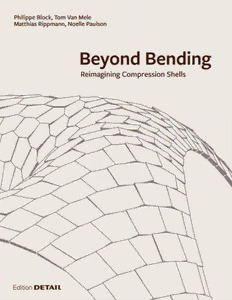
Beyond Bending: Reimagining Compression Shells PDF
Preview Beyond Bending: Reimagining Compression Shells
Philippe Block, Tom Van Mele Matthias Rippmann, Noelle Paulson Beyond Bending Reimagining Compression Shells CONTENTS 6 Foreword La Biennale di Venezia 11 Reporting from the Front The War on Bending By Alejandro Aravena 12 In the Footsteps of Vitruvius By John Ochsendorf Beyond Bending 178 Afterword 15 A New Research-Driven 17 Beyond the Slab I Architectural Practice By Gilles Retsin 20 Building with Weak Material 33 Beyond the Slab II 184 Authors 186 Contributors 42 Building with Less Material 187 Exhibition and Object Credits 55 Beyond the Dome 188 Image Credits 190 Bibliography 64 Exploring Form and Forces 79 Beyond Freeform 90 Extending Stereotomy The Making of the Armadillo Vault 101 103 Form and Structure 116 Engineering the Extreme A Conversation with Ochsendorf DeJong & Block 127 Stereotomy and Fabrication 138 Informing Geometry A Conversation with the Block Research Group 147 Construction and Assembly 170 Balancing Craft and Machine A Conversation with the Escobedo Group FOREWORD La Biennale di Venezia For a world of beams and slabs built with steel-reinforced concrete, compres- sion-only shell structures, which can be extremely thin constructions, offer the potential to drastically reduce material requirements. Building with fewer materials means in turn less environmental strain caused by the construction industry. Drawing from a revival of forgotten principles combined with the latest methods for reimagining the design, engineering, fabrication and construction of compression shells, this book advocates for the logic of such forms. Through in-depth background on the state-of-the-art research, advanced engineering, and highly-skilled masonry craft that resulted in the Armadillo Vault and other innovations exhibited at La Biennale di Venezia, the 15th International Architec- ture Exhibition in 2016, by the Block Research Group, ETH Zürich, Ochsendorf DeJong & Block, and the Escobedo Group, it demonstrates dramatic ways to move beyond bending. In August 2015, in his role as the newly appointed curator of La Biennale di Venezia, Alejandro Aravena wrote to Philippe Block and John Ochsendorf to invite them to contribute to his exhibition “Reporting from the Front”. Aravena specifically asked Block and Ochsendorf to submit a report from the front of their “War on Bending”. Ideas quickly coalesced to form the plan for an exhi- bition entitled Beyond Bending. Their goal was to show what can be achieved when reinforced concrete slabs, which normally work in bending, instead take on curved, compression-only forms. A team was formed to include the Block Research Group at ETH Zürich (led by Philippe Block and Tom Van Mele), the engineering consultancy of Ochsendorf DeJong & Block (comprised of John Ochsendorf, professor at MIT, Matthew DeJong, professor at the University of Cambridge, and Philippe Block) and the construction and masonry experts of the Escobedo Group (led by David and Matt Escobedo). Although the team members had been collaborating in various constellations for over 10 years, the invitation to exhibit at the Biennale represented their first opportunity on such a large scale and on the world’s premier stage for architectural innovation. Aravena’s initial invitation included the statement, “The battle for a better built environment is neither a tantrum nor a romantic crusade”. This sentiment also fittingly describes what the team accomplished in Venice. The objects that were displayed in the Beyond Bending exhibition – and whose precedents, principles, and potentials are described in greater depth on the pages that follow – represent efforts toward achieving a better built environment. With their focus on compression-only structures, they show methods for more ap- 6 propriate construction. They demonstrate more efficient use of materials and labour in various contexts from developing countries in Africa to prosperous, high-income countries like Switzerland. Rather than being romantic attempts at revival for revival’s sake, these structures draw upon historical examples and “lost” techniques that have been reinvigorated and adapted for current technological and fabricational possibilities. Thus, the exhibition carried the subtitle “Learning from the past to design a better future”. . Beyond Bending filled an entire room in the Corderie dell’Arsenale, a former workshop for the production of naval ropes, the initial construction of which began as early as 1303. For this exhibition, four examples of vaulted floor sys- tems displayed in two of the corners formed “Beyond the Slab I” and “Beyond the Slab II”; a canvas of 19 form and force diagrams covering one wall consti- tuted “Beyond the Dome”; and the Armadillo Vault, the exhibition’s centrepiece under the rubric of “Beyond Freeform”, spanned an area of 75 square metres. Visitors could enter the exhibition from one of two large, arched doorways. To move through the room, they were forced to either walk around or under the Armadillo Vault, with each path providing different perspectives. The format of this book follows the structure of the exhibition and its head- ings. “Beyond Bending” describes the objects displayed in Venice. Each section begins with a short explanatory text taken from the original exhibition labels followed by photographs to provide visual context. Then, pages with a shaded background allow for more in-depth, theoretical analysis. These sections each present precedents, principles, and potentials. They indicate past or present references, describe the architectural, computational, and/or structural meth- ods behind the objects, and propose future possibilities for development and innovation. The second section charts the “Making of the Armadillo Vault” through photographs, diagrams, texts, and conversations with the team leaders covering various aspects of the vault’s realisation. This variety of perspectives demonstrates how constraints informed the design, engineering, fabrication, and construction of this remarkable structural achievement. Top view and sections of the Beyond Bending exhibition in the Arsenale building of La Biennale di Venezia, showing its main components. 7 8 Original proposal with hand-drawn sketches submitted to curator Alejandro Aravena in September 2015. 9
